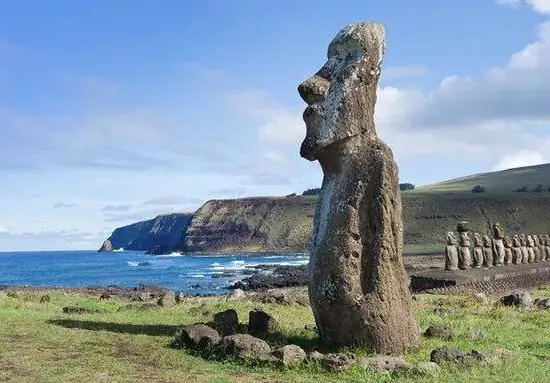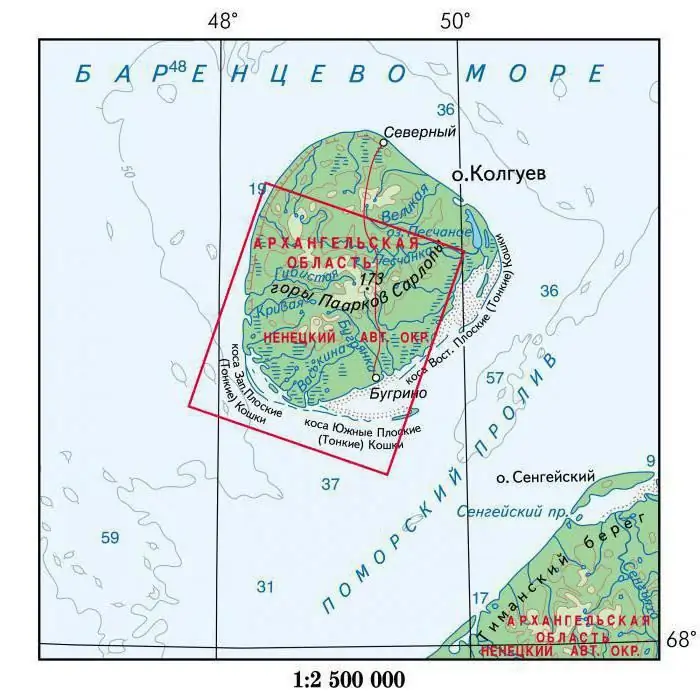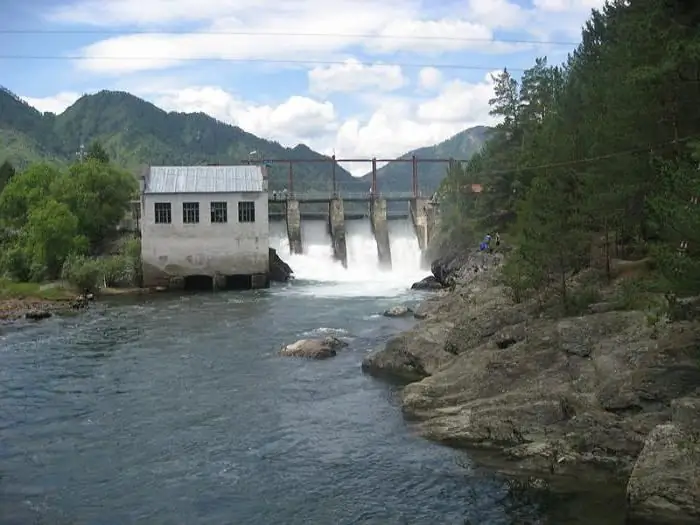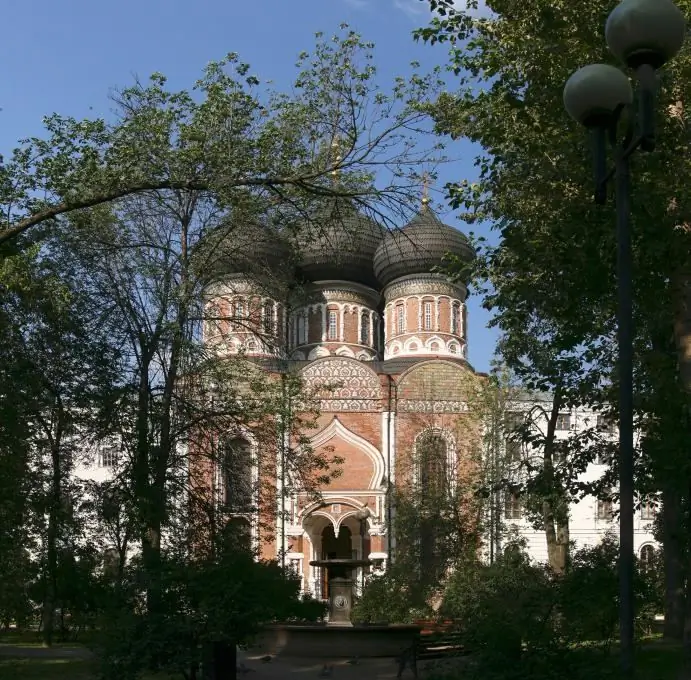- Author Harold Hamphrey [email protected].
- Public 2023-12-17 10:06.
- Last modified 2025-01-24 11:10.
Paramushir is one of the northern islands of the Kuril Islands and is located at a slight distance from the Kamchatka Peninsula. This is an area with a rather harsh climate. It belongs to the territory of Russia, to the Sakhalin region. The name of the island is translated as "big". So called him the Ainu, the people who lived in the old days on the Japanese islands. According to other versions, the name means "crowded". Although now it is difficult to call it such. The only settlement on the island of Paramushir is Severo-Kurilsk, the number of inhabitants in which barely exceeds two and a half thousand people.

Description
Paramushir belongs to the northern group of the Kuril Islands along with such as Onekotan and Traps. Nearby, even to the north, is the smaller island of Shumshu. Neighboring territories are separated by the Second Kuril Strait. The area of Paramushir Island is approximately two thousand kilometers, it is one of the largest in the archipelago.
Here there are volcanoes, mountains, several lakes, the most famous of which is Mirror. Climatic conditions are characterized by strong winds at any time of the year, sometimes they reach more than 200 kmin hour. Therefore, there are few trees and large shrubs on the island, the forest zone is practically absent. Life here is also not easy: in the winter season, the snow level exceeds the limit. Often, residents have to rake the entrance to the dwelling littered with snow with a shovel. Other issues: potential and occasional floods, earthquakes, eruptions.
From history
Until the beginning of the 18th century, the Ainu lived on the island of Paramushir, not accepting the power of Russia. The people refused to pay taxes in kind to the state until armed Cossacks arrived on the territory. After that, the Ainu submitted to the authorities. From the 30s they accepted the Orthodox faith, entered into citizenship. Later, the population began to die out. The cause is believed to be a smallpox epidemic. In 1875, Paramushir was handed over to the Japanese, and the area began to be populated again. The first city appeared (now Severo-Kurilsk). The Japanese were engaged in fishing, founded the port. And during World War II, the territory was occupied by the military. Artillery was installed here, an airport was founded for air defense.
In 1945, Soviet paratroopers arrived on Paramushir, and the Japanese had to surrender. The territory became part of the Soviet Union. The settlements were renamed, the Russians began to move there, equip their homes, and run a household. But the peaceful existence did not last long. In 1952, a tsunami struck Paramushir.

The lack of a warning system caused a large number of victims of the elements. Settlements were destroyed. The recovery went slowly. Severo-Kurilsk was practically rebuilt.
Severo-Kurilsk
The settlement was founded in the northern part of the island, not far from it - the ruins of the Japanese airfield during the war. Previously, the city was called Kasivabora. At a distance of several kilometers, the Ebeko volcano rises. Its peak is located at an altitude of 1037 m. A little further away is Mount Nasedkina, ten meters higher than the volcano. Other settlements remained on the island, there are about eight in total, but after the tsunami, the existing buildings were not restored. Because the villages are still empty. Residents of the city are mainly engaged in fishing, there is a plant for its processing and processing of seafood.

There are children's schools on the island of Paramushir, including a music school; in the mid-70s of the last century, the House of Culture was opened, where concerts and festive events are held. In the 1990s, a new hospital appeared. Now there is even a small museum dedicated to the nature and history of the region.
Flora and fauna
If we compare the species diversity of plants and living creatures of the Paramushir Island and the Kamchatka Territory, the number of species in the second territorial zone is much higher. Island vegetation is poorer. Of the shrubs, there is practically only one variety - oud willow. The plant is resistant to cold and winds. It also grows in China, Yakutia. Most often it can be found near rivers.
In the warm season, residents gather blueberries and lingonberries. Alder anda kind of lily, saranka. On the slopes of the hills you can find a common in Russia and unusually useful plant willow tea. As for animals, a unique animal lives in these parts - the Paramushir shrew. You can meet foxes, whites, brown bears dangerous to humans. There are a lot of fish, most of all they catch pink salmon and sockeye salmon. The sea depths near the island are the habitat of Japanese whales.
Chikurachki Volcano
On the Karpinsky Ridge, far from the city, you can see a stratovolcano. Still active, periodically covering the surrounding area with ash. One of its last “awakenings” occurred in July 2016. The ash reached an area 100 km from the volcano, covered houses and cars in Severo-Kurilsk with a thin layer. Among the recorded last eruption was noted in 2015. Experts say that the volcano does not pose a great danger to the residents of the city: it is located quite far away. But there is a certain threat to overflying planes.

The duration of recent weak eruptions usually ranged from a few days to a couple of weeks. The last of the powerful ones happened in 1986. Then the volcano threw out lava flows, and the ash rose to a height of 11 kilometers. The process took at least three weeks.
Cape Vasiliev on Paramushir Island
Crossing the island along its length, you can reach Cape Vasiliev. On the way you will meet the Karpinsky volcano, several rivers that will have to be forded. A lot of equipment and structures of the times remained on the cape.war. There is also a lighthouse where several people live permanently. In the district there are old aircraft hangars, a former Japanese airfield, pillboxes and other buildings. You can see in these places Soviet tanks, tractors, various weapons used in World War II and abandoned later. The equipment has rusted and is now unusable.
Behind Cape Vasiliev on the Paramushir Island of the Kuril Islands is Cape Kapustny (if you follow the direction from Severo-Kurilsk).
The element does not sleep
There are frequent earthquakes in these parts. The locals are used to them and know what tactics to follow. In September 2017, there was a big flood on Paramushir Island. Part of the buildings and equipment in Severo-Kurilsk were hidden under water. The cause of the flood was an increase in the water level in the river after prolonged rains. The course changed and headed straight for the city. Similar incidents often happen in Paramushir. But the most terrible threat is another tsunami or typhoon. However, people have already learned to predict such phenomena. And, if something threatens human lives, everyone will be notified and prepared in advance. Even temporary evacuation is possible.
How to get there?
You can swim to the island on a specially rented sea vessel. For example, on a small ship for twenty to thirty seats. However, the cost of renting such a vehicle is quite high. The starting point of the route is usually Petropavlovk-Kamchatsky, from the bay of which ships leave. Arriving from Yuzhno-Sakhalinskproblematic: the distance is more than 1300 km. Near the islands, passengers are transferred to inflatable boats. While the ship is going through the registration procedure, passengers on boats moor to the shore.

Subsequently, groups of tourists should also be checked by border services. The main thing is to have a passport with you (foreign - for residents of foreign countries). Another way to get to Paramushir Island is by helicopter. But changeable weather allows you to do this only on certain days. The price of a flight (renting an aircraft) is also extremely high.
What to see?
First of all, tourists come to Paramushir to see the unique places of untouched nature. The raging sea, numerous waterfalls, peaks of mountains and volcanoes create an amazing landscape. You can take great photos on Paramushir Island if the weather is good. Which, by the way, is quite rare. It is best to visit places in August, this month is considered the warmest of the year. It is undesirable to visit in February: severe frosts and a significant layer of snow will not allow you to enjoy the beauties of nature.
Travellers interested in wartime history and technology will be interested in looking at fortifications left over from the time when the region belonged to Japan.

But you should be careful when walking around the island: there may be old shells on the ground that have not had time to explode. Otherthe danger is associated with a meeting with bears. However, animals try not to catch the eye of people. Do not forget about the likelihood of eruptions. You can ask your guide or local residents about the rules of conduct in such situations.
Walks around the island
Before the trip, you need to stock up on food and medicine, as well as warm clothes and the most comfortable shoes. Tourists who set as their goal a multi-day hike with ascents should take into account that on the route they will have to ford rivers and streams. The lowlands are usually damp and foggy. Drizzling rains here are a constant tourist companion. Caution should be passed by the Japanese wartime trenches. Some of the holes are already overgrown and can easily fall through.

Crossing the territory to Cape Vasiliev, it is unlikely to meet people on the way. Not far from the city there are small waterfalls up to 15 meters in height. If you walk along the coastline, then you can see the 50-meter waterfalls of Paramushir Island. Where they are can be determined by the nearby rivers.






